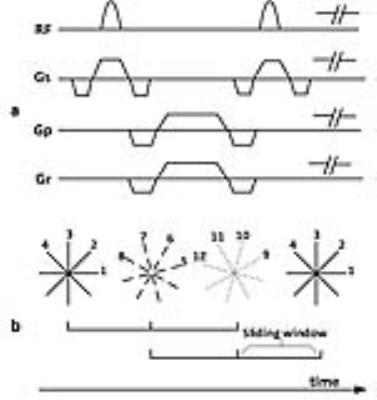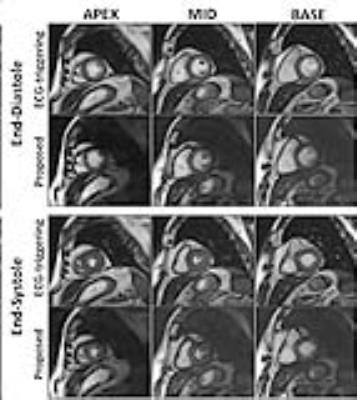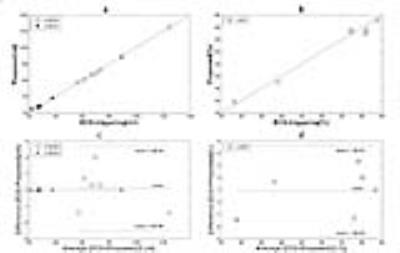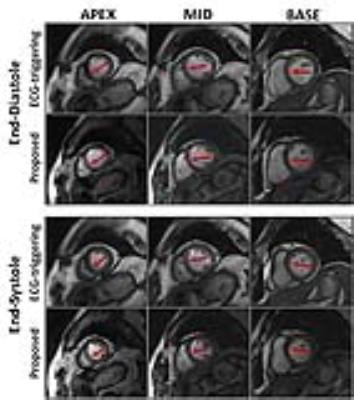3153
Real-time cardiac cine based on a radial bSSFP sequence and compressed sensing: initial experience on the evaluation of left ventricular function in patients1Centers for Biomedical Engineering, University of Science and Technology of China, Hefei, People's Republic of China, 2Shenzhen Institutes of Advanced Technology, Chinese Academy of Sciences, Shenzhen, People's Republic of China, 3Beijing Anzhen Hospital, Capital Medical University, Beijing, People's Republic of China, 4Centers for Biomedical Engineering, University of Science and Technology of China, Heifei, People's Republic of China, 5Cedars-Sinai Medical Center, Los Angeles, CA, United States
Synopsis
Cardiac cine magnetic resonance imaging is a valuable technique for assessing cardiac function. However, conventional cardiac cine imaging is based on breath-holding and ECG-triggering, which has particularly difficulty to be used for the diagnosis of the patients with arrhythmia. In this work, a novel technique for real-time cardiac cine imaging was developed and used to evaluate the left ventricular (LV) function in patients with arrhythmia. Preliminary experiment results demonstrated that the proposed method can accurately evaluate patient’s LV function without the use of ECG triggering and improve the image quality of the patients with arrhythmia.
Introduction
Cardiac cine magnetic resonance (MR) imaging is a valuable technique for assessing cardiac function. However, conventional cardiac cine imaging is based on breath-holding and ECG-triggering, which has particularly difficulty to be used for the diagnosis of the patients with arrhythmia. This is because arrhythmia often causes irregular heartbeats, resulting in incorrect ECG-triggering and thus complicated cardiac phase synchronization. In this work, a novel technique for real-time cardiac cine imaging was developed and used to evaluate the left ventricular (LV) function in patients with arrhythmia.Methods
Sequence: A bSSFP sequence with radial sampling trajectory was developed for real-time cardiac cine imaging without the use of ECG-triggering (Figure 1a). Because even distribution radial sampling had more uniform angular spacing over the entire range of temporal resolutions, it was adopted for data acquisition in the sequence. In addition, to improve temporal stability, a view-sharing technique was employed for data acquisition and image reconstruction. (Figure 1b).
Image reconstruction: The image reconstruction exploits the image sparsity in k-t space, which can be formulated as Eq.(1).
$$argmin\left\{\lambda_{1}\parallel\triangledown_{s}\rho\parallel_{1}+\lambda_{2}\parallel\triangledown_{t}\rho\parallel_{1}\right\} subjectto \parallel d-PF\left(\tilde{S}\rho\right)\parallel_2^2$$
where P is sampling matrix, F is the NUFFT operator, $$$\widetilde{s}$$$ is coil sensitivities, ρ denotes the image series to be reconstructed, d is the acquired data, $$$\triangledown_{s}$$$ and $$$\triangledown_{t}$$$ are the spatial and temporal total-variation (TV) operators, λ1 and λ2 are the regularization weights. The reconstruction was implemented in MATLAB, using a tailored version of conjugate gradient algorithm.
In vivo experiment
IRB-approved cardiac cine imaging was performed on 6 patients without arrhythmia and 8 patients with arrhythmia at 3T (Siemens Verio, Germany) with a 32-element receive coil. The 6 patients without arrhythmia were recruited for assessing the accuracy of the proposed real-time imaging method on the evaluation of the LV function. 2D short-axis cine images were obtained in a stack of 7-12 contiguous slices spanning the entire left ventricle from the base to the apex for all patients. Typical imaging parameters for the proposed real-time imaging method included: TR=3.0ms, TE =1.52ms, field of view=220mm, spatial resolution = 1.4×1.4×8.0mm3, bandwidth =1359 Hz/Pixel, temporal resolution = 36ms. Conventional bSSFP sequence with breath-holding and ECG-triggering was conducted at the same slice locations for comparison. The imaging parameters of the conventional bSSFP sequence included: TR=3.5ms, TE =1.51ms, field of view=340mm, spatial resolution = 1.3×1.3×5.0mm3, bandwidth =977Hz/Pixel, temporal resolution = 41ms.Image Analysis
To assess the capability of the proposed real-time method on evaluating the left ventricular (LV) function, the LV end-diastolic volume (LV-EDV), the LV end-systolic volume (LV-ESV) and the LV ejection fraction (LV-EF) were respectively calculated using Argus software (Siemens Medical Solutions, Germany) and compared with those obtained by the conventional ECG-triggering approach in all 6 patients without arrhythmia. The agreement between the proposed and conventional methods was then statistically analyzed using linear regression and Blank Altman plot. In addition, to investigate whether the proposed method can improve the cardiac cine imaging in the presence of arrhythmia, contrast-to-noise ratio (CNR) between blood and myocardium were calculated for all 8 patients with arrhythmia. Wilcoxon sign-rank test was then used to statistically analyze the CNR difference between the proposed and conventional methods. Statistical significance was defined as p < 0.05.Results and discussion
All MR scans were successfully conducted. For the study of the patients without arrhythmia, cardiac cine images obtained by the proposed method were comparable with those by conventional ECG-triggering approach (Figure 2). In addition, LV-EDV, LV-ESV and LV-EF between the proposed and conventional methods were all well in agreement (Figure 3). This demonstrated that the proposed method was feasibility for accurately evaluating patient’s LV function. For the study of the patients with arrhythmia, the images obtained by the proposed method showed significant improvement of image quality with better CNR between blood and myocardium (12.3±3.4 vs 9.1±3.9, p = 0.004) and less motion artifacts (red arrows on Figure 4), which could be used for the evaluation of LV function.Conclusion
A real-time
cardiac cine imaging technique
was developed and evaluated on patients for LV function diagnosis. Preliminary
experiment results demonstrated that the proposed method could accurately
evaluate patient’s LV function without the use of ECG triggering and improve
the image quality of the patients with arrhythmia. It has potential to be clinically
useful for the cardiac cine imaging in the patients with arrhythmia.Acknowledgements
National Key Research and Development Program of China (2016YFC0100302), Natural Science Foundation of China(81571669, 61201442) and the Natural Science Foundation of Shenzhen (JCYJ20160331185933583, GJHZ20150316143320494, KQCX2015033117354154), and the Natural Science Foundation of Guangdong (2014B030301013).References
[1] Zhang S, Block K T, Frahm J. Magnetic resonance imaging in real time: advances using radial FLASH[J]. Journal of Magnetic Resonance Imaging, 2010, 31(1): 101-109. [2] Ying L, Sheng J. Joint image reconstruction and sensitivity estimation in SENSE (JSENSE)[J]. Magnetic Resonance in Medicine, 2007, 57(6): 1196-1202. [3] Uecker M, Hohage T, Block K T, et al. Image reconstruction by regularized nonlinear inversion—joint estimation of coil sensitivities and image content[J]. Magnetic Resonance in Medicine, 2008, 60(3): 674-682.Figures



